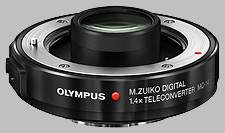| 1.4x |
$350 average price |
|---|---|

|
|
Your purchases support this site
Buy the Olympus 1.4X MC-14
Olympus MC-14 Review
12/09/2014
by William Brawley
Announced back in September 2014 for Photokina alongside the Olympus 40-150mm ƒ/2.8 Zuiko Pro, the tiny and robust Olympus MC-14 1.4x teleconverter offers Micro Four Thirds users not only the first focal length extender for the Micro Four Thirds system, but also one that maintains the rugged, splashproof build of the Olympus 40-150mm ƒ/2.8 Zuiko Pro lens.
Currently compatible only with the 40-150mm ƒ/2.8 lens, the 1.4x teleconverter gives the focal length range a boost up to 56-210mm (112-420mm in 35mm equivalents), but with the typical 1-stop of light loss (the ƒ/2.8 aperture stops down to an ƒ/4). The 1.4xTC will also be compatible with Olympus's upcoming 300mm ƒ/4 Zuiko Pro telephoto lens for a 420mm ƒ/5.6-equivalent lens (an 840mm equivalence in 35mm terms).
With an all-metal construction with full weather-sealing, the Olympus MC-14 is comprised of six optical elements, including one "HR" element, and is currently available for pre-order for around $349.
Sharpness
Testing the teleconverter with the 40-150mm ƒ/2.8 produced excellent results, especially at the shorter focal lengths. Wide open at 56mm, the lens and teleconverter produced very sharp images across the frame. Stopping down a bit to ƒ/5.6 improved corner sharpness slightly for nearly uniform sharpness across the entire frame. At 100mm (aka 70mm without the TC), we see a similar behavior as we did at 56mm -- excellent sharpness wide-open at ƒ/4 with subtle corner sharpness improvements when stopping down. We did see a slight drop in image sharpness at 210mm, unfortunately, but overall, the image quality is still impressive, just not as critically sharp as the lens performs without the teleconverter at this focal length.
We also still see some effects of diffraction-induced softness at the extreme apertures between ƒ/16 - ƒ/22, which is also more of an issue at the longer focal lengths.
Chromatic Aberration
Interestingly, we actually see less chromatic aberration when using the teleconverter on the 40-150 ƒ/2.8 than with the lens alone, except at the long end, where CA actually increased quite a bit. At 56mm, we see very well-controlled CA, both on average and in maximum values (normally corner CA), at 40mm on the bare lens, both average and maximum CA is noticeably stronger. We see similar behavior at the middle focal length as well. At 100mm (70mm+TC), average and maximum CA is a little higher than at 56mm, but not by much, and stopping down a bit quickly reduces CA further.
However, at 210mm (150mm+TC), the chromatic aberration increases noticeably, both on average and in maximum values. In our sample VFA test shots, bright cyan and red CA fringing is clearly visible in the corners. Without the teleconverter, the CA at 150mm is only a little bit stronger than the CA at 56mm (40mm+TC).
Shading (''Vignetting'')
Similar to the bare 40-150mm lens, the vignetting with the Olympus 1.4 teleconverter is very, very low. Vignetting wide open at ƒ/4 is already extremely low with the TC attached, and past ƒ/5.6, vignetting is practically nonexistent.
Distortion
The Olympus 40-150mm ƒ/2.8's excellent distortion control is not affected by the addition of the new Olympus 1.4x teleconverter. At all focal lengths, the level of barrel distortion sits just a hair above the zero mark.
Autofocus Operation
On the 40-150mm f/2.8 lens, the teleconverter does not significantly impact the focusing speed of this already-fast lens, if at all. In our assessment of the lens by itself, it was indeed very quick and accurate to acquire focus, taking well under a second to rack from minimum focus distance to infinity. With the teleconverter attached, the lens felt similarly fast to rack through the full focus range.
Macro
The teleconverter itself doesn't increase or decrease the minimum focusing distance of the lens. The 40-150mm ƒ/2.8 has a very close focusing distance, which is quite unique for this type of lens. With the TC attached, you can get a bit more magnification, for an even closer view of your subject. While the product information from Olympus for the MC-14 TC indicates that macro shooting is possible at a working distance of 20 inches (50 cm), the specs indicate that the close focusing distance remains identical to that of the master lens. In the case of the 40-150 ƒ/2.8, it's closest focusing distance is actually 27.6 inches (70.1 cm).
Build Quality and Handling
The Olympus MC-14 teleconverter shares a similar design and build quality to the other Olympus Zuiko Pro lenses -- an all-metal construction, with a semi-gloss black finish on the barrel and full weather sealing -- splashproof, dustproof and freezeproof. Both mounting ends are metal, with a rubberized gasket seal where the teleconverter mounts to the camera. Olympus managed to squeeze five lens groups composed of six elements -- including one high refractive (HR) element inside this one-inch-wide lens accessory.
As for size and shape, the MC-14 teleconverter is extremely small and compact. It weights practically nothing (101.5g actually) and is barely noticeable when mounted on the 40-150mm ƒ/2.8 lens.
As with most teleconverters, some of the lens elements protrude into the end of the accompanying lens, which is why most TCs are compatible with only a select number of lenses. In the case of the Olympus MC-14, it's currently only compatible with the newly announced Olympus 40-150mm ƒ/2.8 Zuiko Pro lens, though it will be compatible with the upcoming 300mm ƒ/4 Zuiko Pro lens as well. Attached to the 40-150, the TC feels solid and strong without any looseness or wiggling between the TC and camera or the TC and lens.
Also characteristic of teleconverters is light loss. While the 1.4x teleconverter magnifies the focal length of the 40-150mm lens to 56-210mm (112-420mm in 35mm equivalents), it also drops the lens down from a constant ƒ/2.8 aperture lens to a constant ƒ/4 lens. (The 300mm f/4 will then become a 420mm f/5.6-equivalent lens.)
Alternatives
As of this writing, the Olympus MC-14 is the only teleconverter designed for the Micro Four Thirds lenses, and as such, there aren't any competing alternatives.
Conclusion
Priced at $349, the mini Micro Four Thirds 1.4x teleconverter from Olympus is a sizable chunk of change. However, the build quality is excellent; just like Olympus's other Zuiko Pro lenses. It's also extremely small, lightweight, fully weather-sealed and doesn't negatively impact image quality or AF speed to a significant degree. If you own or are planning to own the Olympus 40-150mm ƒ/2.8 Zuiko Pro or 300mm ƒ/4 Zuiko Pro lens, the MC-14 teleconverter is a no-brainer accessory to have in your kit.
Product Photos
 |  |  |  |
Sample Photos
The VFA target should give you a good idea of sharpness in the center and corners, as well as some idea of the extent of barrel or pincushion distortion and chromatic aberration, while the Still Life subject may help in judging contrast and color. We shoot both images using the default JPEG settings and manual white balance of our test bodies, so the images should be quite consistent from lens to lens.
As appropriate, we shoot these with both full-frame and sub-frame bodies, at a range of focal lengths, and at both maximum aperture and ƒ/8. For the ''VFA'' target (the viewfinder accuracy target from Imaging Resource), we also provide sample crops from the center and upper-left corner of each shot, so you can quickly get a sense of relative sharpness, without having to download and inspect the full-res images. To avoid space limitations with the layout of our review pages, indexes to the test shots launch in separate windows.
Olympus 1.4X MC-14
Your purchases support this site
Micro Four Thirds - Black
Olympus 1.4X MC-14 User Reviews
-
Invisible! No discernible image degradation.Extra bit of plastic keeps it from working with E-System adapters — I milled it off!
This is a wonderful teleconverter that is essentially invisible, with respect to image quality. Put it on an outstanding lens, and the result will still be outstanding! But don't expect wonders if you put it on a mediocre lens.
reviewed February 22nd, 2019 (purchased for $184)
My biggest disappointment is that it would not fit any E-System adapter I tried. This turns out to be because of a bit of plastic that Olympus put in there to keep it from working on certain lenses, and an extra bit of plastic in every adapter I tried, including MMF-2, MMF-3, and several different cheap Chinese "no name" adapters.
I carefully removed the extra bit of plastic, and widened the opening in my E-System adapters, and now it works with them like a charm!
I further describe the modifications on mu-43s.com: https://www.mu-43.com/threads/teleconverters-or-extenders.100930/page-2#post-1211238
My purchase price was for a mint used copy on evilBay. -
Sharp, Fast, Very good IQ, SealedPrice
No doubt that this is again the prove that Olympus is able to deliver outstanding lens craftsmanship.
reviewed February 19th, 2015 (purchased for $490)
Matches perfectly my 40-150/2.8 PRO. No noticeable AF speed or IQ loss.
looking forward to match up with the 300/4 PRO






